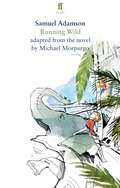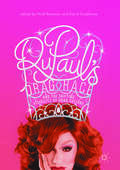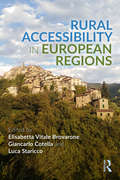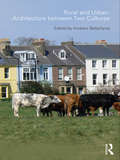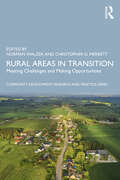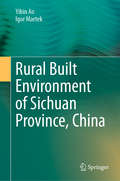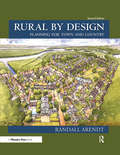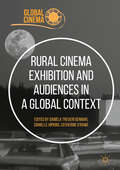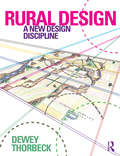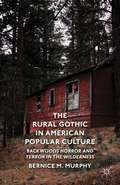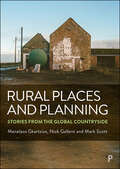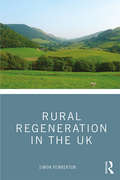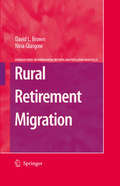- Table View
- List View
Running Wild: Based on the Novel (Collector's Edition Ser.)
by Samuel AdamsonFor Lilly and her mother, going to Indonesia isn't just another holiday. It's an escape and a new start. But when Will takes a gentle ride along the beach on an elephant called Oona, calamity strikes. As a tsunami comes crashing towards them, Oona charges deep into the jungle, her young rider desperately clinging on. Miles from civilisation, there's wonder, discovery and treetop adventures among the orang-utans. But then as Lilly's thoughts turn to his mother left behind on the beach, tigers prowl, hunger hits, and she must learn to survive the rainforest.Samuel Adamson's adaptation of Michael Morpurgo's novel Running Wild was premiered by the Chichester Festival Youth Theatre in 2015. It received its professional premiere in May 2016, in a Regent's Park Theatre and Chichester Festival Theatre co-production.Running Wild was winner of Best Show for Children and Young People at the 2015 UK Theatre Awards.
RuPaul’s Drag Race and the Shifting Visibility of Drag Culture: The Boundaries of Reality TV
by Niall Brennan and David GudelunasThis book identifies and analyzes the ways in which RuPaul’s Drag Race has reshaped the visibility of drag culture in the US and internationally, as well as how the program has changed understandings of reality TV. This edited volume illustrates how drag has become a significant aspect of LGBTQ experience and identity globally through RuPaul’s Drag Race, and how the show has reformed a media landscape in which competition and reality itself are understood as given. Taking on lenses addressing race, ethnicity, geographical origin, cultural identity, physicality and body image, and participation in drag culture across the globe, this volume offers critical, non-traditional, and first-hand perspectives on drag culture.
RuPaul’s Drag Race UK: The Official Companion to Series 3
by Christian GuiltenaneRuPaul's Drag Race UK returns to our screens for Series 3 with an all-new cast ready to slay the runway.Discover the secrets of the Werk Room and get all the gossip backstage in exclusive interviews with the Queens of Series 3. Take on mini challenges, learn the secret to a killer Snatch Game performance, and re-live the most iconic moments of RuPaul's Drag Race UK so far with stories from the Queens of Series 1 and 2. With special features, play-along games, secrets and trivia, this is your perfect companion to the Drag Race extravaganza! Remember kids, reading is fundamental!
Rupturing Architecture: Spatial Practices of Refuge in Response to War and Violence in Iraq, 2003–2023
by Dr Sana MurraniThis is the first book to critically and visually explore the spatial practices of refuge in response to conditions of war, violence, and displacement experienced in Iraq from 2003 to 2023. Written by an Iraqi architect who has lived through the trauma of several wars, 10 years of UN-imposed sanctions, an invasion, and the subsequent violence, this book captures a broad spectrum of spatial responses to trauma and presents a fresh perspective on how ordinary Iraqis create refuge across the spaces of the home, the urban environment, and border geographies. In the face of spatial wounding and the many injustices suffered by the Iraqi people, there has also been a wealth of refuge-making practices that showcase their creative and imaginative design and adaptability to change and trauma over time. Rupturing Architecture employs methods such as creative deep mapping, memory work, storytelling, interviews, and case studies of architectural responses to the geographies of war and violence. At the core of the book are the lived and felt experiences of fifteen Iraqis from across Iraq, whose resilience underscores a broader narrative of spatial justice and feminist spatial practices. The book articulates the dual nature of rupturing as both a sign of trauma and a powerful act of resistance, examining how these forces shape domesticity, urbanity, and border spaces. The concluding manifesto for spatial justice calls for a deep, integrated understanding of place, memory, and trauma, advocating for comprehensive strategies in the making of refuge spaces that also resonate in a wider, global context.
Rupturing Architecture: Spatial Practices of Refuge in Response to War and Violence in Iraq, 2003–2023
by Dr Sana MurraniThis is the first book to critically and visually explore the spatial practices of refuge in response to conditions of war, violence, and displacement experienced in Iraq from 2003 to 2023. Written by an Iraqi architect who has lived through the trauma of several wars, 10 years of UN-imposed sanctions, an invasion, and the subsequent violence, this book captures a broad spectrum of spatial responses to trauma and presents a fresh perspective on how ordinary Iraqis create refuge across the spaces of the home, the urban environment, and border geographies. In the face of spatial wounding and the many injustices suffered by the Iraqi people, there has also been a wealth of refuge-making practices that showcase their creative and imaginative design and adaptability to change and trauma over time. Rupturing Architecture employs methods such as creative deep mapping, memory work, storytelling, interviews, and case studies of architectural responses to the geographies of war and violence. At the core of the book are the lived and felt experiences of fifteen Iraqis from across Iraq, whose resilience underscores a broader narrative of spatial justice and feminist spatial practices. The book articulates the dual nature of rupturing as both a sign of trauma and a powerful act of resistance, examining how these forces shape domesticity, urbanity, and border spaces. The concluding manifesto for spatial justice calls for a deep, integrated understanding of place, memory, and trauma, advocating for comprehensive strategies in the making of refuge spaces that also resonate in a wider, global context.
Rural Accessibility in European Regions
by Elisabetta Vitale Brovarone Giancarlo Cotella Luca StariccoRural Accessibility in European Regions explores concepts, methodologies, and case studies dealing with accessibility in European rural areas, embracing cultural, socioeconomic, and governance aspects that play a key role for accessibility policies in rural and peripheral areas. In the first part, the chapters introduce rural accessibility challenges, present a methodology to support policymaking for enhancing accessibility in rural areas and apply it to case studies in the United Kingdom, Italy, Spain, and Sweden. In the second part, additional cases from Poland, Germany, Greece, and France provide alternative approaches to the topic, and a research agenda is proposed. Overall, the book contributes to a conceptualisation of rural accessibility, addressing challenges and potentials for rural accessibility and urban–rural relationships in European regions. The book fills a gap in the existing bodies of literature on accessibility and on rural planning, bridging the two spheres with an interdisciplinary approach to rural accessibility for mobility, planning, and regional studies.
Rural Accessibility in European Regions
by Elisabetta Vitale Brovarone Giancarlo Cotella Luca StariccoRural Accessibility in European Regions explores concepts, methodologies, and case studies dealing with accessibility in European rural areas, embracing cultural, socioeconomic, and governance aspects that play a key role for accessibility policies in rural and peripheral areas. In the first part, the chapters introduce rural accessibility challenges, present a methodology to support policymaking for enhancing accessibility in rural areas and apply it to case studies in the United Kingdom, Italy, Spain, and Sweden. In the second part, additional cases from Poland, Germany, Greece, and France provide alternative approaches to the topic, and a research agenda is proposed. Overall, the book contributes to a conceptualisation of rural accessibility, addressing challenges and potentials for rural accessibility and urban–rural relationships in European regions. The book fills a gap in the existing bodies of literature on accessibility and on rural planning, bridging the two spheres with an interdisciplinary approach to rural accessibility for mobility, planning, and regional studies.
Rural and Urban: Architecture Between Two Cultures
by Andrew BallantyneInvestigating various ways in which the cultures of the town and the countryside interact in architecture, original essays in this book written by an international range of recognized theorists will help all students of architecture and urban design understand how the urban and rural relate. Taking a broad historical sweep, this collection draws on a symposium of the Society of Architectural Historians of Great Britain.
Rural and Urban: Architecture Between Two Cultures
by Andrew BallantyneInvestigating various ways in which the cultures of the town and the countryside interact in architecture, original essays in this book written by an international range of recognized theorists will help all students of architecture and urban design understand how the urban and rural relate. Taking a broad historical sweep, this collection draws on a symposium of the Society of Architectural Historians of Great Britain.
Rural Areas in Transition: Meeting Challenges & Making Opportunities (Community Development Research and Practice Series)
by Norman Walzer Christopher MerrettThis volume explores new opportunities to reshape local economies in rural areas during the next decade by exploring successful efforts already underway. While reported population declines can paint a bleak picture for rural areas, a different story can be told in looking at the numbers of households, employment, and housing markets. In fact, many rural areas have had steady employment and healthy housing markets. Rural attractions often include proximity to natural recreation areas, personal safety, social interaction, less expensive housing, and high-quality education. This book shows that rural areas are in a major long-term transition and that local leaders who take advantage of these opportunities in their community and economic development strategies can create a very positive future for residents. Students and policymakers in local economic development, sociology of population change, business finance, political economy, and geography will find this a useful resource.
Rural Areas in Transition: Meeting Challenges & Making Opportunities (Community Development Research and Practice Series)
by Norman Walzer Christopher D. MerrettThis volume explores new opportunities to reshape local economies in rural areas during the next decade by exploring successful efforts already underway. While reported population declines can paint a bleak picture for rural areas, a different story can be told in looking at the numbers of households, employment, and housing markets. In fact, many rural areas have had steady employment and healthy housing markets. Rural attractions often include proximity to natural recreation areas, personal safety, social interaction, less expensive housing, and high-quality education. This book shows that rural areas are in a major long-term transition and that local leaders who take advantage of these opportunities in their community and economic development strategies can create a very positive future for residents. Students and policymakers in local economic development, sociology of population change, business finance, political economy, and geography will find this a useful resource.
Rural Arts Management (Discovering the Creative Industries)
by Elise Lael Kieffer Jerome SocolofThe arts and arts management exist in every corner of the world, from the largest city to the smallest town. However, just as a metropolis and a hamlet bear little resemblance to each other despite similar basic needs, arts organizations in the former frequently bear little resemblance to those in the latter, and many foundational arts management texts give little attention to rural settings. This book combines insights from research and practice to fill that knowledge gap and help readers understand arts administration in rural communities.Focusing on the North American setting but including comparative examples and references from around the world, this book examines how areas of practice familiar to any arts manager work in rural areas, including research and best practices for navigating the paucity of resources frequently encountered in rural communities. Emphasizing a “by rural, for rural” perspective, this book frames the arts as integral components of vibrant rural communities and valuable tools for meeting these communities’ needs.Written by arts and nonprofit management professors with backgrounds in rural arts research and practice, this book provides a valuable resource for scholars, advanced students and reflective practitioners at the intersection of the arts and rural studies.
Rural Arts Management (Discovering the Creative Industries)
by Elise Lael Kieffer Jerome SocolofThe arts and arts management exist in every corner of the world, from the largest city to the smallest town. However, just as a metropolis and a hamlet bear little resemblance to each other despite similar basic needs, arts organizations in the former frequently bear little resemblance to those in the latter, and many foundational arts management texts give little attention to rural settings. This book combines insights from research and practice to fill that knowledge gap and help readers understand arts administration in rural communities.Focusing on the North American setting but including comparative examples and references from around the world, this book examines how areas of practice familiar to any arts manager work in rural areas, including research and best practices for navigating the paucity of resources frequently encountered in rural communities. Emphasizing a “by rural, for rural” perspective, this book frames the arts as integral components of vibrant rural communities and valuable tools for meeting these communities’ needs.Written by arts and nonprofit management professors with backgrounds in rural arts research and practice, this book provides a valuable resource for scholars, advanced students and reflective practitioners at the intersection of the arts and rural studies.
Rural Built Environment of Sichuan Province, China
by Yibin Ao Igor MartekMajor changes are taking place in the Chinese countryside as China rushes to modernizes and urbanizes its rural fabric. The transformation is improving the quality of life of rural inhabitants, but also brings about challenges as people strive to adjust. This book systematically examines the impact of change on the daily lives and activities of the residents of Sichuan Province, in China’s South-west. It examines the themes of infrastructure, transport modes and preferences, sanitation, water conservation, earthquake and flood disaster preparedness, and the impact these have on villager behavior and quality of life. This book is an essential reference guide for graduate students and practitioners in the fields of rural planning, renewal, and construction.
Rural by Design: Planning for Town and Country
by Randall ArendtFor America’s rural and suburban areas, new challenges demand new solutions. Author Randall Arendt meets them in an entirely new edition of Rural by Design. When this planning classic first appeared 20 years ago, it showed how creative, practical land-use planning can preserve open space and keep community character intact. The second edition shifts the focus toward infilling neighborhoods, strengthening town centers, and moving development closer to schools, shops, and jobs. New chapters cover form-based codes, visioning, sustainability, low-impact development, green infrastructure, and more, while 70 case studies show how these ideas play out in the real world. Readers —rural or not—will find practical advice about planning for the way we live now.
Rural by Design: Planning for Town and Country
by Randall ArendtFor America’s rural and suburban areas, new challenges demand new solutions. Author Randall Arendt meets them in an entirely new edition of Rural by Design. When this planning classic first appeared 20 years ago, it showed how creative, practical land-use planning can preserve open space and keep community character intact. The second edition shifts the focus toward infilling neighborhoods, strengthening town centers, and moving development closer to schools, shops, and jobs. New chapters cover form-based codes, visioning, sustainability, low-impact development, green infrastructure, and more, while 70 case studies show how these ideas play out in the real world. Readers —rural or not—will find practical advice about planning for the way we live now.
Rural Cinema Exhibition and Audiences in a Global Context (Global Cinema)
by Daniela Treveri Gennari Danielle Hipkins Catherine O’RaweAlthough it has only been in the last decade that the planet’s population balance tipped from a predominantly rural makeup towards an urban one, the field of cinema history has demonstrated a disproportionate skew toward the urban. Within audience studies, however, an increasing number of scholars are turning their attention away from the bright lights of the urban, and towards the less well-lit and infinitely more variegated history of rural cinema-going. Rural Cinema Exhibition and Audiences in A Global Context is the first volume to consider rural cinema-going from a global perspective. It aims to provide a rich and wide-ranging introduction to this growing field, and to further develop some of its key questions. It brings together eighteen international scholars or teams, all representatives of a dynamic, new field. Moving beyond a Western focus is essential for thinking through questions of rural exhibition, distribution and cinema experience, since over the relatively short history of cinema it is the rural that has dominated cinema-goers’ lives in much of the developing world. To this end, the volume also innovates by bringing discussions of North American and European ruralities into dialogue with contributions on Kenya, Brazil, China, Thailand, South Africa and Australia.
Rural Design: A New Design Discipline
by Dewey ThorbeckRural areas worldwide are undergoing profound change creating considerable challenges and stress for its residents and on the ecosystems upon which they depend. Rural design brings design thinking and the problem-solving process of design to rural issues recognizing that human and natural systems are inextricably coupled and engaged in continuous cycles of mutual influence and response. This book is the first step along the path for rural design to emerge as an important new design discipline. Rural Design: A New Design Discipline establishes the theoretical base for rural design and the importance of looking at connecting issues to create synergy and optimal solutions from a global, national, state, region, and local perspective. To be effective and relevant, this new discipline must be founded on solid research, and practice must be based on data-driven evidence that will result in transformational changes. These directions and others will enable rural design to: help rural communities make land use, architectural, and aesthetic decisions that enhance their quality of life and the environment connect social, artistic, cultural, technological, and environmental issues that create rural place promote sustainable economic development for rural communities and improve human, livestock, crop, and ecosystem health and integrate research and practice across the many disciplines involved in rural issues to meet rural needs, provide new data, and provoke new research questions. Written by a world leading expert in rural design, who is director and founder of the University of Minnesota Center for Rural Design, the book is oriented toward students, academics and design professionals involved with rural design at any level.
Rural Design: A New Design Discipline
by Dewey ThorbeckRural areas worldwide are undergoing profound change creating considerable challenges and stress for its residents and on the ecosystems upon which they depend. Rural design brings design thinking and the problem-solving process of design to rural issues recognizing that human and natural systems are inextricably coupled and engaged in continuous cycles of mutual influence and response. This book is the first step along the path for rural design to emerge as an important new design discipline. Rural Design: A New Design Discipline establishes the theoretical base for rural design and the importance of looking at connecting issues to create synergy and optimal solutions from a global, national, state, region, and local perspective. To be effective and relevant, this new discipline must be founded on solid research, and practice must be based on data-driven evidence that will result in transformational changes. These directions and others will enable rural design to: help rural communities make land use, architectural, and aesthetic decisions that enhance their quality of life and the environment connect social, artistic, cultural, technological, and environmental issues that create rural place promote sustainable economic development for rural communities and improve human, livestock, crop, and ecosystem health and integrate research and practice across the many disciplines involved in rural issues to meet rural needs, provide new data, and provoke new research questions. Written by a world leading expert in rural design, who is director and founder of the University of Minnesota Center for Rural Design, the book is oriented toward students, academics and design professionals involved with rural design at any level.
The Rural Gothic in American Popular Culture: Backwoods Horror and Terror in the Wilderness
by B. MurphyThe Rural Gothic in American Popular Culture argues that complex and often negative initial responses of early European settlers continue to influence American horror and gothic narratives to this day. The book undertakes a detailed analysis of key literary and filmic texts situated within consideration of specific contexts.
Rural Places and Planning: Stories from the Global Countryside
by Menelaos Gkartzios Nick GallentRural Places and Planning provides a compact analysis for students and early-career practitioners of the critical connections between place capitals and the broader ideas and practices of planning, seeded within rural communities. It looks across twelve international cases, examining the values that guide the pursuit of the ‘good countryside’. The book presents rural planning – rooted in imagination and reflecting key values – as being embedded in the life of particular places, dealing with critical challenges across housing, services, economy, natural systems, climate action and community wellbeing in ways that are integrated and recognise broader place-making needs. It introduces the breadth of the discipline, presenting examples of what planning means and what it can achieve in different rural places.
Rural Places and Planning: Stories from the Global Countryside
by Menelaos Gkartzios Nick GallentRural Places and Planning provides a compact analysis for students and early-career practitioners of the critical connections between place capitals and the broader ideas and practices of planning, seeded within rural communities. It looks across twelve international cases, examining the values that guide the pursuit of the ‘good countryside’. The book presents rural planning – rooted in imagination and reflecting key values – as being embedded in the life of particular places, dealing with critical challenges across housing, services, economy, natural systems, climate action and community wellbeing in ways that are integrated and recognise broader place-making needs. It introduces the breadth of the discipline, presenting examples of what planning means and what it can achieve in different rural places.
Rural Regeneration in the UK
by Simon PembertonRural Regeneration in the UK provides an accessible yet critical overview of rural regeneration policy and governance in the UK. It charts the key patterns and processes of rural change since 1945 and the emergence and evolution of rural regeneration policy and governance in shaping rural spaces. A key objective of the book is to highlight how, and to what extent, rural regeneration policy and governance are responsive to an increasingly differentiated and uneven rural economy and society. Part One considers the context for rural regeneration, including theoretical frameworks of relevance and the ways in which rural regeneration policy and governance have been framed. In particular, it includes a consideration of how the rural has been made ‘thinkable’, and the extent to which this has moved beyond traditional concerns with agricultural development. Part Two highlights the key dimensions and spaces of rural regeneration. This includes responses to rural change from ‘within the rural’, including community-led approaches, the use of culture and the extent to which approaches may be converging or diverging within a devolved UK. Rural Regeneration in the UK provides a comprehensive and integrated analysis of responses to rural change that will appeal to a broad audience of students, scholars and practitioners both in the UK and abroad.
Rural Regeneration in the UK
by Simon PembertonRural Regeneration in the UK provides an accessible yet critical overview of rural regeneration policy and governance in the UK. It charts the key patterns and processes of rural change since 1945 and the emergence and evolution of rural regeneration policy and governance in shaping rural spaces. A key objective of the book is to highlight how, and to what extent, rural regeneration policy and governance are responsive to an increasingly differentiated and uneven rural economy and society. Part One considers the context for rural regeneration, including theoretical frameworks of relevance and the ways in which rural regeneration policy and governance have been framed. In particular, it includes a consideration of how the rural has been made ‘thinkable’, and the extent to which this has moved beyond traditional concerns with agricultural development. Part Two highlights the key dimensions and spaces of rural regeneration. This includes responses to rural change from ‘within the rural’, including community-led approaches, the use of culture and the extent to which approaches may be converging or diverging within a devolved UK. Rural Regeneration in the UK provides a comprehensive and integrated analysis of responses to rural change that will appeal to a broad audience of students, scholars and practitioners both in the UK and abroad.
Rural Retirement Migration (The Springer Series on Demographic Methods and Population Analysis #21)
by David L. Brown Nina GlasgowThis fascinating book examines rural retirement migration from the older in-migrants’ perspective and from the vantage point of the destination communities to which they move. This integrated approach permits the authors to view older in-migrants as embedded in environments that facilitate and/or constrain their opportunities for productive living during older age. It also permits the examination of positive and negative effects of older in-migration for destination communities.
